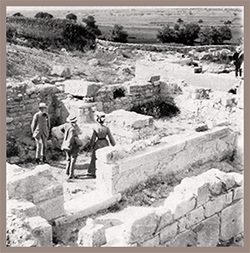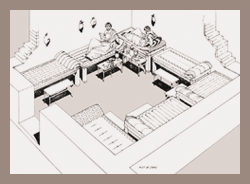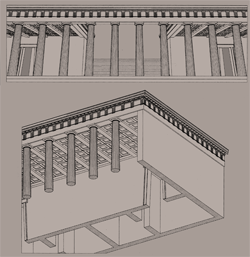scarica l’articolo in formato pdf: Lo hestiatorion dell’Asklepieion di Kos
.
 Il presente contributo riprende il testo del IV mimiambo di Eronda, che, ambientato presso l’Asklepieion di Kos, narra la visita di due donne al santuario e il sacrificio di un gallo al dio. Il poeta trae spunto dalla narrazione per descrivere i monumenti e le opere d’arte via via incontrate e ammirate dai personaggi, descrizione che è stata molto studiata e analizzata specie a proposito dell’altare, opera dei figli di Prassitele, e delle pitture nel pronao dell’antistante tempio. Non ci si era però fino ad ora soffermati sugli ultimi versi del poemetto, in cui, dopo il sacrificio del gallo, le due donne si propongono di andare a consumare il proprio pasto nei vicini oikoi. Prendendo spunto dal testo di Eronda, l’articolo vuole confermare la destinazione come sala per banchetti rituali dell’edificio subito a Sud del tempio, il cosiddetto “edificio D”, generalmente noto come abaton; verso di esso, infatti, potrebbero essersi dirette le due donne dopo il sacrificio.
Il presente contributo riprende il testo del IV mimiambo di Eronda, che, ambientato presso l’Asklepieion di Kos, narra la visita di due donne al santuario e il sacrificio di un gallo al dio. Il poeta trae spunto dalla narrazione per descrivere i monumenti e le opere d’arte via via incontrate e ammirate dai personaggi, descrizione che è stata molto studiata e analizzata specie a proposito dell’altare, opera dei figli di Prassitele, e delle pitture nel pronao dell’antistante tempio. Non ci si era però fino ad ora soffermati sugli ultimi versi del poemetto, in cui, dopo il sacrificio del gallo, le due donne si propongono di andare a consumare il proprio pasto nei vicini oikoi. Prendendo spunto dal testo di Eronda, l’articolo vuole confermare la destinazione come sala per banchetti rituali dell’edificio subito a Sud del tempio, il cosiddetto “edificio D”, generalmente noto come abaton; verso di esso, infatti, potrebbero essersi dirette le due donne dopo il sacrificio.
.
This paper resumes the text of the IV mimiamb of Herodas, which, set at the Asklepieion of Kos, tells of the visit at the sanctuary of two women and their sacrifice of a cock to the god. In his tale the poet describes the monuments and works of art encountered and admired by the characters, description that has been widely studied and analyzed especially with regard to the altar, with the statues made by the sons of Praxiteles, and the famous paintings on the walls of the pronaos of the temple. So far, however, no scholar has focused on the last verses of the poem, in which, after the sacrifice of the cock, the two women purposed to go and eat their meal in the nearby oikoi. Taking inspiration from the text of Herodas, the article will confirm the destination as a ritual banquet hall of the building immediately to the south of the temple, the so-called “building D”, generally known as abaton; towards it, in fact, the two women may have gone after sacrifice to eat their meal.


